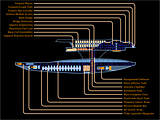But I, too, cannot possibly imagine a Deadalus Class starship like the Horizon to be capable landing on a planet as the vessel or parts of it would buckle under their own weight much like a stranded whale, neither can I imagine they had magic technology (like they apparently had for
Voyager) at this point in time in the in-universe history.
So how can we possibly rationalize it?
I'd say it's a bad thing to start any kind of relation based on a lie. Had the
Horizon crew just used a shuttle craft and present this as their "ship", the Sigma Iotians would eventually find out in the future.
As fully adopted UFP members doing historical research the older UFP members would have a diplomatic tiger on their tail to explain why they started relations based on a lie, especially (see the very bottom of this post) since the UFP apparently cherishes the "truth" above almost all things...
But if the
Horizon's secondary hull and nacelles merely registered as a "warp sled", then the actual "ship", capable of independent (impulse power) propulsion, would be the primary hull (i.e. sphere).
We'd have a reasonable explanation without the necessity of going into rationalization overdrive, IMHO.
If we look at Jefferies' early TOS
Enterprise "ringship" designs and the subsequent XCV 330 proposals, we'll notice that in the early design stage there wasn't the "enviropod" but actually a space shuttle reminiscent vehicle with the obvious capability to detach and land on a planet.
Back to the Daedalus Class I see a rather flimsy cylinder connecting the sphere with the secondary hull that somehow doesn't make sense to me in terms of structural warp stress durability. As a means to facilitate separation of the primary sphere from the secondary hull, I could buy that.
Apparently, "the ship won't land" line is an afterthought of the meticulous screenplay writer/s David P. Harmon and/or Gene L. Coon.
A basic plot premise is that the Sigma Iotians demand physical proof that Kirk and company are not merely local imposters (for all we know the transporter beam effect could be a part of a local entertainment show featuring their version of a Chris Angel

).
Any foresighted Federation official of the mid-22nd Century "First Contact program" would have understood this and therefore a physical display of the "ship" was inevitable (a concept that became obsolete with the introduction of the Prime Directive. A warp capable culture would no longer have required such a physical proof, having other means to determine that the visitors from outer space are for real).
But what kind of physical display? A spaceship with warp nacelles that could and would have instantly been mistaken as cannons, rocket or missile launchers by the alien natives! ?!

Obviously a display that awes but does not intimidate and I believe the only shape that qualifies as such would be the sphere as it's a universal shape that carries familiar allusions to stars and planetary bodies (think
E.T....). And the Daedalus Class primary hull / sphere has no external features that could be mistaken for weapons, neither does the Oberth Class saucer.
I further think that the Olympic Class hospital ships of the late 24th Century perfectly reflect this design philosophy and "We come in peace and mean [can do] no harm" intention.
I rest my case.



 - revolves around Star Trek -
- revolves around Star Trek -  - and discusses pseudoscientific treknological issues -
- and discusses pseudoscientific treknological issues -  )
)



 ).
).


 ), but I also posted a couple of comments there until the very end and read Andrew Probert's replies. But I don't recall one that suggests what you stated here. It seems to be somewhat out of context, and before we have some new myth-building at the expense of Andrew Probert I couldn't help but to intervene.
), but I also posted a couple of comments there until the very end and read Andrew Probert's replies. But I don't recall one that suggests what you stated here. It seems to be somewhat out of context, and before we have some new myth-building at the expense of Andrew Probert I couldn't help but to intervene.
